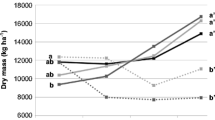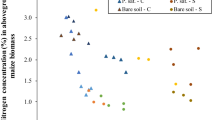Abstract
The aim of this study, which was conducted in a humid savannah zone of central Côte d’Ivoire, was to examine changes in the quality of soil cultivated with herbaceous legume cover crops as a function of initial soil characteristics. Mucuna pruriens var utilis and Pueraria phaseoloides were used in a two side-by-side location experiment: a shrubby savannah (the savannah site or “SAV”) and a natural fallow dominated by Chromolaena odorata (the fallow site or “FAL”). The latter was mainly characterized by higher organic matter [organic carbon (C) 10 vs. 7.5 mg kg−1; total nitrogen (N) 0.8 vs. 0.5 mg kg−1) and total phosphorus (P) (282.3 vs. 168.3 mg kg−1) contents in the upper soil layer (0–10 cm). After 8 months of growth, biomass production by M. pruriens was found to be 6.5 and 4.9 t dry matter (DM) ha−1 at FAL and SAV, respectively. For P. phaseoloides, the values were 7.2 and 6.4 t DM ha−1, respectively, in approximately the same period. The quantities of nutrients released by decomposing legume litter were higher at FAL than at SAV. Between-site differences in soil quality improvement were most noticeable in terms of available P, microbial biomass carbon (MBC) and MBC:total carbon (TC) ratio. The FAL site experienced a faster improvement of soil parameters under both legume species: available P increased from 18 to 58 mg kg−1 under M. pruriens, and from 19 to 52 mg kg−1 under P. phaseoloides; MBC increased from 88 to 185 mg kg−1 under M. pruriens, and from 127 to 192 mg kg−1 under P. phaseoloides. In contrast, the parameters remained constant over time at SAV. Soil C and N contents as well as C mineralization showed similar trends at both sites. Based on these results, we conclude that soil quality improvement under cover crops appears to be faster when the initial soil organic C, total N and P contents are adequate. These findings will be useful in assisting governmental decision-making on approaches to be taken for restoring soil fertility in low-input agricultural systems in West Africa.








Similar content being viewed by others
References
Albiach H, Canet R, Pomares F, Ingelmo F (2000) Microbial biomass content and enzymatic activities after the application of organic amendments to a horticultural soil. Biores Technol 25:43–48
Anderson JM, Ingram JSI (1993) Tropical soil biology and fertility, a handbook of methods, 2nd edn. CAB Int, New York
Anthofer J, Kroschel J (2005) Above-ground biomass, nutrients, and persistence of an early and a late maturing Mucuna variety in the forest–savanna transitional zone of Ghana. Agr Ecosyst Environ 110:59–77
Azontonde A, Feller C, Ganry F, Remy JC (1998) Le mucuna et la restauration des propriétés d’un sol ferrallitique au sud du Bénin. Agr Dév 18:55–61
Balesdent J, Balabane M (1996) Major contribution of roots to soil carbon storage inferred from maize cultivated soils. Soil Biol Biochem 9:1261–1263
Bekku Y, Koizumi H, Oikawa T, Iwaki H (1997) Examination of four methods for measuring soil respiration. Appl Soil Ecol 5:247–254
Berish CW, Ewel JJ (1988) Root development in simple and complex tropical successional ecosystems. Plant Soil 106:73–84
Bernhard-Reverat F, Masse D, Harmand J-M (2000) Qualité des litières et décomposition dans les jachères naturelles. In: Floret Ch, Pontanier R (eds) La jachère en Afrique tropicale: rôles, aménagements, alternatives. Actes du séminaire de Dakar, Avril 1999, vol 1. John Libbey Eurotext, Paris, p 194
Blair BC, Perfecto I (2001) Nutrient content and substrate effect on fine root density and size distribution in a Nicaraguan rain forest. Biotropica 33:697–701
Böhme L, Böhme F (2006) Soil microbiological and biochemical properties affected by plant growth and different long-term fertilisation. Eur J Soil Biol 42:1–12
Carsky RJ, Becker M, Hauser S (2001) Mucuna cover crop fallow system: potential and limitations. In: Carsky RJ et al. (eds) Sustaining soil fertility in West Africa. SSSA Special Publication 58. Soil Science Society of America, Madison, pp 111–135
Chadwick DR, Ineson P, Woods C, Pearce TG (1998) Decomposition of Pinus sylvestris litter in litter bags: influence of underlying native litter layer. Soil Biol Biochem 30:47–55
Cleveland CC, Townsend AR, Constance BC (2004) Soil microbial dynamics in Costa Rica: seasonal and biogeochemical constraints. Biotropica 36:184–195
Cong PT, Merckx R (2005) Improving phosphorus availability in two soils of Vietnam using Tithonia diversifolia H. Plant Soil 269:11–23
Dalal RC, Henry RJ (1986) Simultaneous determination of moisture, organic carbon, and total nitrogen by near-infrared reflectance spectrophotometry. Soil Sci Soc Am J 50:120–123
Demoling F, Figueroa D, Baath E (2007) Comparison of factors limiting bacterial growth in different soils. Soil Biol Biochem 39:2485–2495
Dinesh R, Suryanarayana MA, Chaudhuri Ghoshal S, Sheeja TE (2004) Long term influence of leguminous cover crops on the biochemical properties of a sandy clay loam fluvientic sulfaquent in a humid tropical region of India. Soil Till Res 77:69–77
Emmerling C, Schloter M, Hartman A, Kandeler E (2002) Functional diversity of soil organisms—a review of recent research activities in Germany. J Plant Nutr Soil Sci 165:408–420
Feller C, Beare MH (1991) Physical control of soil organic matter in the tropics. Geoderma 79:69–116
Fontaine S, Mariotti A, Abbadie L (2003) The priming effect of organic matter: a question of microbial competition? Soil Biol Biochem 35:837–843
Gower ST (1987) Relations between mineral nutrient availability and fine root biomass in two Costa Rica wet forests: a hypothesis. Biotropica 19:171–175
Ha KV, Marschner P, Bünemann EK, Smernik RJ (2007) Chemical changes and phosphorus release during decomposition of pea residues in soil. Soil Biol Biochem 39:2696–2699
Hassink J (1997) The capacity of soils to preserve organic C and N by their association with clay and silt particles. Plant Soil 191:77–97
Horwarth WR, Paul EA (1994) Microbial biomass. In: Weaver RW, Angle JS, Bottomley PS (eds) Methods of soil analysis, part 2—microbiological and biochemical properties. Soil Science Society of America, Madison, pp 753–773
Houngnandan P, Sanginga N, Okogun A, Vanlauwe B, Merckx R, Van Cleemput O (2001): Assessment of soil factors limiting growth of Mucuna in farmers’ fields in the derived savanna of the Benin Republic. Biol Fertil Soils 33:416–422
Jenkinson DS, Ladd JN (1981) Microbial biomass in soil: measurement and turnover. In: Paul EA, Ladd JN (eds) Soil biochemistry, vol 5. Dekker, New York, pp 415–471
Kolawole GO, Tian G, Tijani-Eniola H (2003) Dynamics of phosphorus fractions with natural vegetation and planted Pueraria phaseoloides in south-western Nigeria. Plant Soil 257:63–70
Koné WA, Tondoh EJ, Bernhard-Reversat F, Loranger-Merciris G, Brunet D (2008) Changes in soil biological quality under legume- and maize-based farming systems in a humid savanna zone of Ivory Coast. Biotechnol Agron Soc Environ (in press)
Kramer C, Gleixner G (2006) Variable use of plant- and soil-derived carbon by microorganisms in agricultural soils. Soil Biol Biochem 38:3267–3278
Ludwig B, Khanna PK, Bauhus J, Hopmans P (2002) Near infrared spectroscopy of forest soils to determine chemical and biological properties related to soil sustainability. For Ecol Manage 171:121–132
Maycock CR, Congdon RA (2000) Fine root biomass and soil N and P in North Queensland rain forest. Biotropica 32:185–190
McCarthy GW, Reeves VB, Follet RF, Kimble JM (2002) Mid-infrared and near-infrared diffuse reflectance spectroscopy for soil carbon measurement. Soil Sci Soc Am J 66:640–646
McGrath DA, Comerford NB, Duryea ML (2000) Litter dynamics and monthly fluctuations in soil phosphorus availability in an Amazonian agroforest. For Ecol Manage 131:1–3
Morra MJ, Hall MH, Freeborn LL (1991) Carbon and nitrogen analyses of soil fractions using near-infrared reflectance spectroscopy. Soil Sci Soc Am J 55:288–291
Murphy J, Riley JP (1962) A modified single solution method for the determination of phosphate in natural waters. Anal Chim Acta 27:31–36
Nwoke OC, Vanlauwe B, Diels J, Sanginga N, Osonubi O, Merckx R (2003) Assessment of labile phosphorus fractions and adsorption characteristics in relation to soil properties of West African savanna soils. Agr Ecosyst Environ 100:285–294
Okpara DA, Ikeorgu JEG, Njoku JC (2005) Potential of cover crops for short fallow replacement in low-input systems of maize production in the humid tropics. Trop Subtrop Agroecosyst 5:109–116
Olsen SR, Sommers LE (1982) Phosphorus. In: Page AL, Miller RH, Keeny DR (eds) Methods of soil analysis, part 2—chemical and microbiological properties. Agronomy monograph no. 9. American Society of Agronomy/Soil Science Society of America, Madison, pp 403–430
Oorts K, Vanlauwe B, Merckx R (2003) Cation exchange capacity of organic matter fractions in a Ferric Lixisol with different organic matter inputs. Agr Ecosyst Environ 100:161–171
Riou G (1974) Les sols de la savane de Lamto. In: Analyse d’un écosystème tropical humide: la savane de Lamto (Côte d’Ivoire)—les facteurs physiques du milieu. Publications du laboratoire de Zoologie de l’ENS, Paris, pp 3–38
Schjonning P, Elmholt S, Christensen BT (2004) Soil quality management concepts and terms. In: Schjonning P, Elmholt S, Christensen BT (eds) Managing soil quality challenges in modern agriculture. CABI Publ, New York, p 1
Shenk JS, Westerhaus MO (1991) Population definition, sample selection, and calibration procedure for near infrared reflectance spectroscopy. Crop Sci 31:469–474
Six J, Conant RT, Paul EA, Paustian K (2002) Stabilization mechanisms of soil organic matter: implications for C saturation of soils. Plant Soil 241:155–176
Sparling GP (1997) Soil microbial biomass, activity and nutrient cycling as indicators. In: Pankhurst C, Doube BM, Gupta VVSR (eds) Biological indicators of soil health. CAB Int, New York, p 97
Tian G, Kolawole GO, Kang BT, Kirchhof B (2000) Nitrogen replacement indexes of legume cover crops in the derived savanna of West Africa. Plant Soil 224:287–296
Tian G, Hauser S, Koutika L-S, Ishida F, Chianu JN (2001) Pueraria cover crop fallow system: Benefits and applicability. In: Carsky RJ et al. (eds) Sustaining soil fertility in West Africa. SSSA Special Publication 58. Soil Science Society of America, Madison, pp 137–155
Van Noordwijk M, Cerri C, Woomer PL, Nugroho K, Bernoux M (1997) Soil carbon dynamics in the humid tropical forest zone. Geoderma 79:187–225
Vance ED, Brookes PC, Jenkinson DS (1987) An extraction method for measuring soil microbial biomass C. Soil Biol Biochem 19:703–707
Walkley A, Black IA (1934) An examination of the Degtjareff method for determining soil organic matter, and a proposed modification of the chromic acid titration method. Soil Sci 34:29–38
Wardle D (1992) A comparative assessment of factors which influence microbial biomass carbon and nitrogen levels in soil. Biol Rev Camb Philos Soc 67:321–358
Wick B, Kühne RF, Vlek PLG (1998) Soil microbial parameters as indicators of soil quality under improved fallow management systems in south-western Nigeria. Plant Soil 202:97–107
Acknowledgements
This work was funded by the International Foundation for Science (IFS) and the “Service de Coopération et d’Action Culturelle” (SCAC) at the French Embassy in Abidjan (Côte d’Ivoire). The authors are grateful to Dr. Martine Tahoux (Director of the Ecological Research Centre (CRE), University of Abobo-Adjamé) and Dr. Souleymane Konaté (Director of the Lamto Ecological Research Station) for facilitating the field work, and Prof. Tié-bi Tra (ESA, INP-HB, Yamoussoukro, Côte d’Ivoire) for samples analyses and collaboration. They also thank Yao N’Goran, Konan N’Guessan Jean and Loucou Kouakou Martin (supporting staff of Lamto) for their assistance during field experiments.
Author information
Authors and Affiliations
Corresponding author
Rights and permissions
About this article
Cite this article
Koné, A.W., Tondoh, J.E., Angui, P.K.T. et al. Is soil quality improvement by legume cover crops a function of the initial soil chemical characteristics?. Nutr Cycl Agroecosyst 82, 89–105 (2008). https://doi.org/10.1007/s10705-008-9172-4
Received:
Accepted:
Published:
Issue Date:
DOI: https://doi.org/10.1007/s10705-008-9172-4




